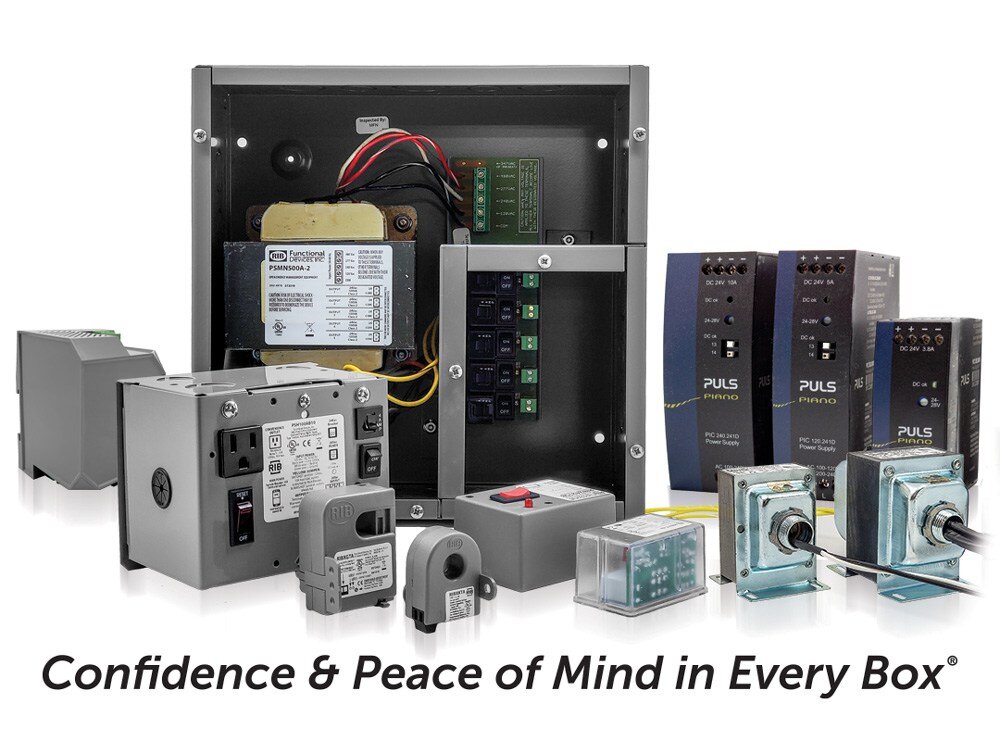Facility managers must continuously optimize their buildings’ energy efficiency to help control operating costs and enhance sustainability. Every electrical component, from current sensors to relays to motors, is scrutinized.
One essential system that uses a lot of a building’s energy is the HVAC, and many facility managers are improving energy efficiency by utilizing electronically commutated motors (ECMs) in their HVAC setups. In addition, ECMs are being used more widely in cooling applications, data centers, and other industrial settings.
Low-sensing current sensors play a key role in ensuring ECM performance and efficiency. Their real-time measurements of energy usage can improve energy savings and reliability. In this post, we’ll explore what ECMs are and why low-sensing current sensors are essential to their use in cooling applications.
Functional Devices specializes in efficient, preassembled electrical components ready for use in various applications, including low-current sensing. For example, our RIBXGTA-ECM model is highly adaptable and offers unmatched precision during current monitoring. Explore more of our current sensor line, and contact us with any questions.
The Benefits of Using ECMs in Cooling Applications and Industrial Settings
In summary, an ECM is essentially a three-phase, brushless DC motor. The motor has a permanent magnetic rotor powered by a control module hooked to a circuit board.

The main difference between an ECM and a more traditional motor is that an ECM can have variable speed control (enabled by electronic switches controlling the direction of the current). In contrast, a traditional motor usually only has fixed speed control. As a result, an ECM can respond dynamically to energy demands, making it more energy efficient.
Here are the key advantages of using ECMs over traditional motors in industrial settings:
- Lower energy consumption
- Quieter operation
- Longer lifespan
- Improved occupancy comfort
- Reduced maintenance
- Wider operating range
- Compact footprint
ECMs are typically used in HVAC systems and refrigeration units, and we expect to see them used more often in data centers and other industrial settings in the future. In HVAC systems, ECMs are used for air handlers, furnace blowers, and condenser/evaporator fans.
How Low-Sensing Current Sensors Improve Energy Efficiency
So, why is using low-sensing current sensors to monitor energy usage important for ECM performance? We’re glad you asked! Let’s lay some groundwork first.
The Need for Current Sensors for Optimized Efficiency
We’ve written before about the importance of using current sensors in commercial settings to improve efficiency. The real-time data they provide on energy consumption can help:
- Detect inefficiencies
- Balance loads
- Protect from system malfunctions
- Optimize efficiency
- Extend equipment lifespan
These same reasons apply when using low-sensing current sensors with ECMs. So why can’t you use a standard current sensor with an ECM?
Why Low-Sensing Current Sensors Are Necessary With ECMs
HVAC and other cooling applications need to respond quickly to shifting system demands. A bunch of people enter a room? The automated HVAC cranks up the AC. They all leave? The system recalibrates. The variable control speed of an ECM allows for responsiveness in the HVAC system (with the help of peripheral electronics).
However, what makes peak ECM performance possible is low-sensing current sensors, which are a type of sensor that can detect very low currents (e.g., 0.25 Amps). Their ability to detect subtle energy fluctuations enables precise load monitoring in the ECM. Benefits include:
- Optimization of ECM operational speed
- Decreased energy waste
- Early detection of system degradation
Precision and the ability to detect low currents are necessary with ECMs because of their built-in inverters, which convert AC power to DC for operation. Even when the motor isn’t rotating, these inverters draw a small amount of AC standby power. A standard current sensor might read that standby power as a false “on,” indicating that the motor is running when it’s not.
A low-sensing current sensor can set a trip point above the standby power and below the lowest operating power, thus providing an accurate status indication and current readings. With this type of sensor, you have an accurate picture of how much energy the ECM uses and can make informed decisions to improve efficiency.
Choose the Right Current Sensor for ECM Optimization
To ensure peak performance and optimize efficiency, consider installing a low-sensing current sensor to monitor any ECMs used in cooling applications or other industrial settings. Their real-time energy consumption data enables facility managers to respond and adjust, balancing loads appropriately, expanding the lifespan of equipment, and detecting wasted energy spent.
Upgrade your sensing technology with help from Functional Devices for long-term energy savings and reliability. We’ve been in the business for a long time and have seen our electrical components shine in numerous applications.
Our split-core, low-sensing RIBXGTA-ECM current sensor can be retrofitted onto an existing ECM setup, giving you the knowledge you need to make educated decisions about improving efficiency. Feel free to reach out to us with questions about optimizing your ECM’s performance with low-sensing current sensors.
About Functional Devices, Inc.

Leaders in the Industry
The world was a very different place in 1969, when Functional Devices, Inc. was founded by engineer and electronics enthusiast Albert Rittmann, but our commitment to evolution and versatility has allowed us to remain a key player in the building automation and lighting controls industry for over 55 years.
Today, as we embrace emerging technology and lean into the future of building automation, our products are still manufactured in the USA with global materials, and we are still committed to our mission of enhancing lives in buildings and beyond. Back in 1969, Albert could never have predicted the technological advances we live with today, but with the groundwork he laid and the vision of his successors, Functional Devices has adapted and grown into a company that can handle anything.
